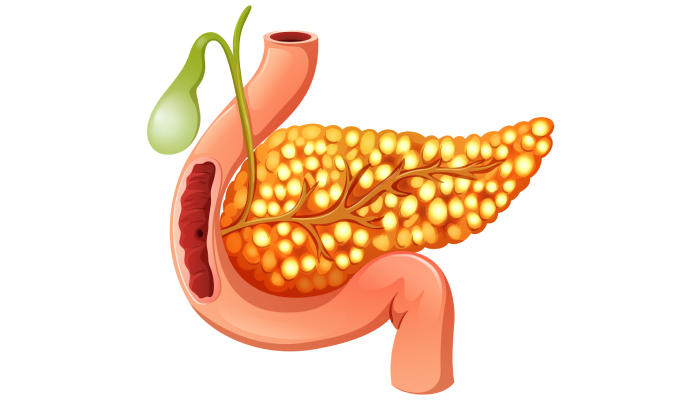What is Pancreas?
The pancreas is a gland, about six inches long, located in the abdomen. It is shaped like a flat pear and is surrounded by the stomach, small intestine, liver, spleen and gallbladder. The wide end of the pancreas on the right side of the body is called the head. The middle sections are the neck and body.
The thin end of the pancreas on the left side of the body is called the tail. The uncinate process is the part of the gland that bends backwards and underneath the head of the pancreas. Two very important blood vessels, the superior mesenteric artery and superior mesenteric vein, cross behind the neck of the pancreas and in front of the uncinate process. The pancreas is both an exocrine gland and endocrine gland and has two main functions – digestion and blood sugar regulation.

Pancreas Conditions
- Diabetes, type 1: The body’s immune system attacks and destroys the pancreas’ insulin-producing cells. Lifelong insulin injections are required to control blood sugar.
- Diabetes, type 2: The body becomes resistant to insulin, causing blood sugar rises. The pancreas eventually loses the ability to appropriately produce and release insulin, leading to a need for synthetic insulin.
- Cystic fibrosis: A genetic disorder that affects multiple body systems, usually including the lungs and the pancreas. Digestive problems and diabetes often result.
- Pancreatic cancer: The pancreas has many different types of cells, each of which can give rise to a different type of tumor. The most common type arises from the cells that line the pancreatic duct. Because there are usually few or no early symptoms, pancreatic cancer is often advanced by the time it’s discovered.
- Pancreatitis: The pancreas becomes inflamed and damaged by its own digestive chemicals. Swelling and death of tissue of the pancreas can result. Although alcohol or gallstones can contribute, sometimes a cause for pancreatitis is never found.
- Islet cell tumor: The hormone-producing cells of the pancreas multiply abnormally, creating a benign or cancerous tumor. These tumors produce excess amounts of hormones and then release them into the blood. Gastrinomas, glucagonomas, and insulinomas are examples of islet cell tumors.
- Enlarged pancreas: An enlarged pancreas is rare. It may be a harmless anatomic abnormality or it may be a sign of autoimmune pancreatitis.
Pancreas Tests
- Physical examination: By pressing on the center of the belly, a doctor might check for masses or abdominal pain. They can also look for other signs of pancreas conditions. Pancreatic pain often radiates to the back.
- Abdominal ultrasound: An abdominal ultrasound can detect gallstones that might block the outflow of fluid from the pancreas. It also can show an abscess or a pancreatic pseudocyst.
- Computed tomography scan: A CT scanner takes multiple X-rays, and a computer creates detailed images of the pancreas and abdomen. Contrast dye may be injected into your veins to improve the images.
- This imaging test can help assess the health of the pancreas. A CT scan can identify complications of pancreatic disease such as fluid around the pancreas, an enclosed infection (abscess), or a collection of tissue, fluid, and pancreatic enzymes (pancreatic pseudocyst).
- Magnetic resonance imaging (MRI): Magnetic waves create highly detailed images of the abdomen. Magnetic resonance cholangiopancreatography (MRCP) is an MRI that focuses on the pancreas, liver, and bile system.
- Endoscopic retrograde cholangiopancreatography (ERCP): Using a camera on a flexible tube advanced from the mouth to the intestine, a doctor can access the area of the pancreas head. Tiny surgical tools can be used to diagnose and treat some pancreas conditions.
- Sweat chloride test: A painless electric current stimulates the skin to sweat, and the chloride in perspiration is measured. People with cystic fibrosis often have high sweat chloride levels.
Pancreas Treatments
- Insulin: Injecting insulin under the skin causes body tissues to absorb glucose, lowering blood sugar. Insulin can be created in a lab or purified from animal sources.
- Pseudocyst drainage: A pseudocyst can be drained by inserting a tube or needle through the skin into the pseudocyst. Alternately, a small tube or stent is placed between either the pseudocyst and the stomach or the small intestine, draining the cyst.
- Pseudocyst surgery: Sometimes, surgery is necessary to remove a pseudocyst. Either laparoscopy (multiple small incisions) or laparotomy (one larger incision) may be needed.
- Pancreatic cancer resection (Whipple procedure): The standard surgery to remove pancreatic cancer. In a Whipple procedure, a surgeon removes the head of the pancreas, the gallbladder, and the first section of the small intestine (the duodenum). Occasionally, a small part of the stomach is also removed.
- Pancreatic enzymes: People with cystic fibrosis or chronic pancreatitis often must take oral pancreatic enzymes to replace those that the malfunctioning pancreas doesn’t make.
- Pancreas transplantation: An organ donor’s pancreas is transplanted into someone with diabetes or cystic fibrosis. In some patients, a pancreas transplant cures diabetes.
- Islet cell transplantation: Insulin-producing cells are harvested from an organ donor’s pancreas and transplanted into someone with type 1 diabetes. The still-experimental procedure can potentially cure type 1 diabetes.
- Pancreatic stenting/pancreatic endotherapy: A stent may be placed in a narrow or blocked pancreatic duct to widen it or to drain extra fluid. It is also used to relieve pain.
Book Your Appointment Today
Book your appointment with Dr. Ujwal Zambare he is having 12 years of experience in Gastro-intestinal surgery, oncology, minimally invasive surgery and Liver, Pancreas, Biliary tract surgery.

Dr. Ujwal Zambare
MBBS, MS (General Surgery), DNB (Gastrointestinal Surgery)
Fellowship in Minimal Access Surgery
Copyright © 2021. Dr. Ujwal Zambare – Liver, Pancreas, Biliary Tract Surgery Specialist in Pune. | All Rights Reserved.
All Text and Images is for information of Patients and Public and doesn’t replace medical practitioners advice. Visit doctor for medical advice.



